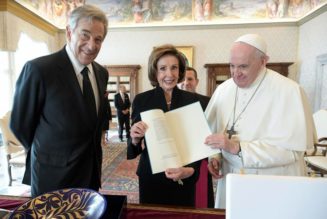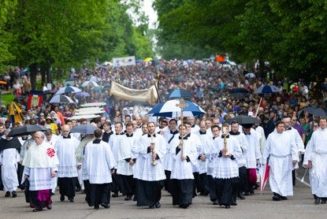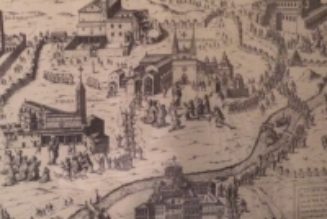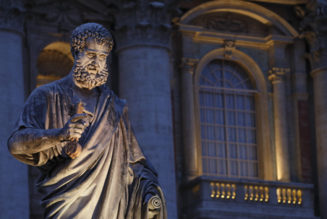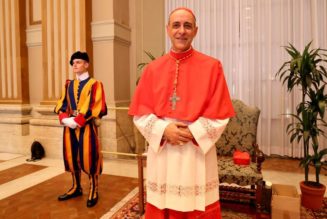
The opaque fabric will rest on the chapel walls of the Saint John Paul II National Shrine in Washington, D.C., like a dressing on a wound.
It’s a fitting image, since the artwork beneath that material has, for many, become a symbol of grave harm — in what ought to be places of hope and healing.
The announcement July 11 that the Knights of Columbus will, for the time being, cover over its mosaics by Father Marko Rupnik at the shrine’s two chapels, as well as the chapel at the organization’s headquarters in New Haven, Connecticut, marks a possible turning point in the ongoing scandal surrounding the disgraced Slovenian priest.
Whether it will prompt shrines like Lourdes and other Catholic institutions around the world to do the same with their works by Father Rupnik remains to be seen.
Just three weeks earlier, the head of the Vatican’s Dicastery for Communications, Paolo Ruffini, told a conference hall full of shocked Catholic journalists that removing or banning Father Rupnik’s art wasn’t a Christian thing to do.
But after months of consultations with theologians, art historians and bishops — and, most importantly, sexual-abuse victims and those who minister to them — the Knights arrived at a different conclusion.
The global fraternal organization, with 2.1 million members, is the largest and most influential lay-run Catholic charity in the world. According to Kelly, the Knights began disassociating itself from Father Rupnik — by starting the process of removing his works from its digital and printed publications — when allegations of serial sexual, psychological and spiritual abuse against the then-Jesuit priest first surfaced in December 2022.
But the question remained: What to do about the Knights’ mosaics?
Some might hear “mosaic” and imagine a framed picture hanging on the wall. Father Rupnik’s famous works are structured on a vastly larger scale.
In effect, they are the walls at installation sites like the John Paul II Shrine, enveloping their spaces from floor to ceiling — which is why removing them is no simple feat.
A security guard can take down a framed piece of art. You need a highly specialized engineering crew to dismantle a Father Rupnik mosaic.
Supreme Knight Patrick Kelly told the Register that destroying the mosaics wasn’t — and won’t be — an option. Not because of the cost, though it would be expensive, but on principle. On that point, the Knights and Ruffini agree. But Kelly said the Knights will consider permanently plastering over the artwork, depending on the outcome of the Vatican’s ongoing investigation of Father Rupnik, who has not spoken publicly about the accusations.
The need to thread the needle on an issue as sensitive as the Father Rupnik scandal presented the Knights with a thorny public-relations challenge. The goals looked something like this:
1. Take decisive, principled, timely action.
2. Demonstrate solidarity and compassion for abuse victims.
3. Respect the Vatican’s ongoing canonical process with Father Rupnik.
4. Don’t destroy any art.
Temporarily covering the mosaics with fabric while leaving the door open to permanently hiding them under plaster checks all those boxes, in an elegantly simple way.
“I hope others will be able to take their cue from what the Knights have done, because I think they’ve come up with a very good, cogent solution,” Dominican Father Thomas Petri, a theologian who heads the Dominican House of Studies in Washington, D.C., located a short walk from the John Paul II Shrine, told the Register.
“I think that the Knights have taken a very brave step,” agreed Mary FioRito, a Catholic lawyer who is the Cardinal Francis George Fellow at the Ethics & Public Policy Center in Washington, D.C., and the de Nicola Center for Ethics and Culture at the University of Notre Dame.
“Somebody had to take the first step,” she added.
A frequent contributor to the Register, FioRito sees the Father Rupnik situation from multiple vantage points.
As a lawyer and the former pro-life director under the late Cardinal Joseph Bernadin of Chicago, whose sexual-abuse accuser later recanted the allegations against him, she appreciates the need for a careful investigation and due process for Father Rupnik.
Yet as a longtime diocesan official, she remains incredulous that despite the seriousness of the allegations and the large number of women who have leveled them, Father Rupnik, who was dismissed by the Jesuits, is still allowed to exercise his priestly faculties in his home country.
When credible accusations are made against other priests, “you’re gone instantly,” she said.
“I mean, I worked for the diocese all those years. I worked for a cardinal for 12 years. Personally, I know what happens. You get a phone call, and you are gone within hours, usually,” she said.
“This entire thing has been very troubling,” she continued. “And I love the Holy Father. I have great respect for his office, but I do not understand what is going on here.”
Finally, as the mother of three daughters, ages 15, 20 and 22, FioRito feels strongly that Father Rupnik’s artwork is no longer capable of what it was intended for, to lift minds and hearts to God.
“I have a very, very hard time even looking at any of the images that he has created,” she said. “That’s very hard to get past, to be honest with you, in a prayer context.”
Father Petri goes even further, arguing that if it’s true that Father Rupnik desecrated religious sisters who are consecrated to God as part of his artistic process, as his accusers allege, his artwork is sacrilegious.
Others may disagree with the Knights’ decision. In the end, though, there is only one true masterpiece in the John Paul II Shrine chapels, and he resides in the tabernacle.
